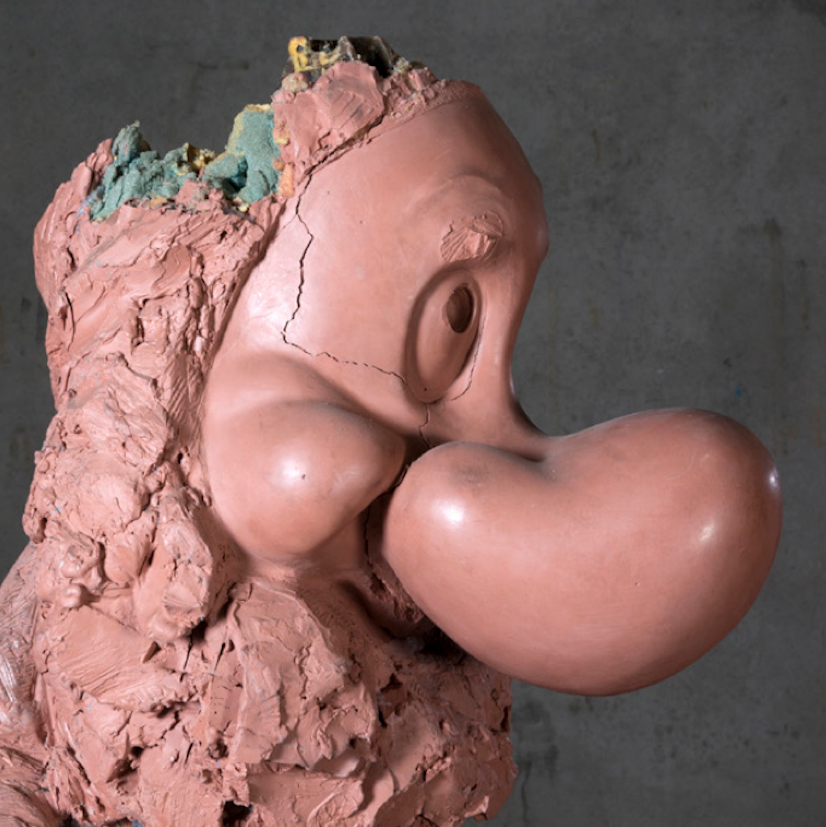NEW YORK CITY — We have an exciting show from the New York branch of Hauser & Wirth. Paul McCarthy is currently exhibiting Raw Spinoff Continuations (NYC November 10 – January 14, 2017), which features a collection of clay sculptures that served as casts for his finished bronze works. We love the decay, the erosion, in the casts that layer iterative meanings that have progressed further forward in time than the finished bronze works. The corroding vintage pop culture aesthetic of some of the pieces puts us in mind of artists like Kristen Morgin.
Above image: Paul McCarthy, White Snow Dwarf, Bashful (affected original), 2009-2016; clay, foam, steel and wood,
From the gallery:
Hauser & Wirth will present a new series by McCarthy of bronze White Snow Dwarfs alongside the original clay sculptures from which they were cast. These most recent works in the artist’s major ongoing project White Snow vividly illustrate the roles that repetition and variation play in his oeuvre. McCarthy’s 2013 video installation at the Park Avenue Armory White Snow is the modern interpretation of Walt Disney’s beloved 1937 animated classic film Snow White and the Seven Dwarfs, in which the original stories’ archetypal narratives are pitched against real human drives and desires.
McCarthy’s original sculpted clay dwarves were altered and distorted variations of Disney’s Seven Dwarfs. Even in their original iterations, McCarthy’s clay figures possessed additional layers of abstraction as a result of having been sculpted and re-sculpted via the artist’s frantic and impulsive performative process. They were subsequently cast in silicone (2010 – 2012), and although those richly colored versions are not included in Raw Spinoffs Continuations, they are integral manifestations of the journey that has produced this remarkable body of work to date. The process of silicone casting abstracted the original clay sculptures further, so that a second casting in bronze have acquired a new degree of rawness and pathos. Presented en masse, McCarthy’s bronze and clay dwarves reveal the artist‘s engagement with the life cycles of materials and together elicit meditations upon time, mortality, and the role of art in a realm of thought beyond the limits of flesh.

Paul McCarthy, White Snow Dwarf, Sleepy#1 (affected original) 2009 – 2016; clay, steel and foam, 61 1/2 x 48 x 48 inches

Paul McCarthy; Chop Chop, Chopper, Amputation; 2013; clay, wood, mixed materials, 141 3/4 x 425 1/4 x 137 3/4 inches
Also on view in the exhibition will be the large-scale installation Chop Chop, Chopper, Amputation (2013 – 2016) from McCarthy’s Caribbean Pirates series. In this darkly carnivalesque work, a pair of disjoined clay figures wearing huge pirate hats, loom over a landscape littered with broken body casts, chairs, wooden platforms, sex toys, buckets, mugs, among other detritus, all punctuated by dollops of viscous, deep yellow polyurethane foam. Inspired by the Disneyland attraction “Pirates of the Caribbean,” the Caribbean Pirates project began in 2001 as a collaboration between Paul McCarthy and his son Damon McCarthy; it has produced a prodigious body of work, including sculptures, performance, and film. Chop Chop, Chopper, Amputation is the merging of a pair of individual large- scale works in the series, based on two drawings by McCarthy – ‘Chopper’ and ‘Amputation’ – that were originally intended to stand independently from one another. Envisioned as a pirate boat, the installation rests on carpets that stand in for water filled with debris: the trash that has been thrown overboard by the vessel’s unruly occupants.
About the Artist
Born in 1945 in Salt Lake City, Utah, Paul McCarthy is one of the most important and influential contemporary American artists. He is known for challenging, visceral work in a variety of mediums – from performance, photography, video, and installation, to sculpture, drawing and painting – and scales ranging from tiny to monumental. Playing on popular illusions, delusions, and cultural myths, his work has often incorporated obsessive activities and challenged expected physical orientation. Absent or present, the human figure has been a constant in his work, whether through the artist‘s own performances or the army of characters he has created to deliberately confuse codes, mix high and low culture, and provoke an analysis of our fundamental beliefs.

Paul McCarthy, White Snow Dwarf, Grumpy, 2016, bronze, 72 x 60 x 60 inches. Image by Walla Walla Foundry.

Paul McCarthy, White Snow Dwarf, Bashful, 2016, bronze, 70 x 60 x 60 inches. Image by Walla Walla Foundry.
McCarthy studied art at the University of Utah and went on to receive a BFA in painting at the San Francisco Art Institute in 1969. He studied film, video, and art at the University of Southern California, receiving an MFA in 1972. From 1982 to 2002, he taught performance, video, installation, and performance art history at the University of California, Los Angeles.
Text (edited) and images courtesy of Hauser & Wirth.
Do you love or loathe these works of contemporary ceramic art? Let us know in the comments.







Add your valued opinion to this post.